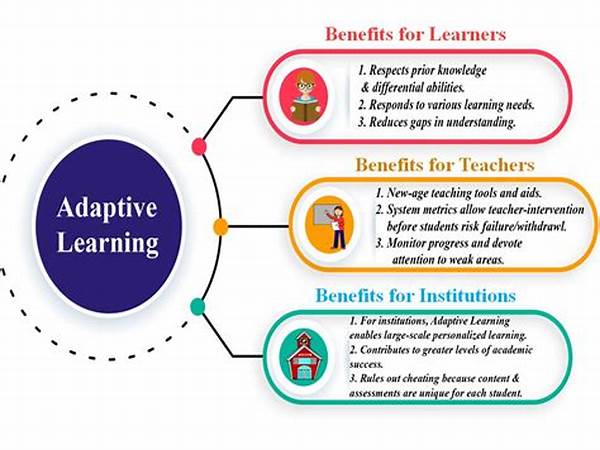- The Key Advantages of Adaptive Learning Systems
- The Purpose Behind Adaptive Learning Systems
- The Impact on Student Engagement
- Longevity and Scalability
- Why Adaptive Systems Continue to Thrive
- How Adaptive Learning Drives Success
- Summarized Insights on Adaptive Learning
- Why Adaptive Learning Outperforms Traditional: An In-depth Analysis
- Bridging Gaps with Adaptive Learning
Why Adaptive Learning Systems Outperform Traditional
Read More : The Future Of Personalized Learning With Ai
In the ever-evolving landscape of education, there’s a buzzword that’s been making waves: adaptive learning. If you’re wondering why adaptive learning systems outperform traditional ones, you’re about to embark on an informative journey. Picture this: a classroom where every student’s learning pace is unique, where lessons adapt in real time to the students’ understanding, and where engagement is at its peak. This is not a futuristic fantasy, but the revolutionary adaptation already making a significant impact in educational settings worldwide. Traditional learning was once the go-to approach, a one-size-fits-all model that, while foundational, often left some students trailing behind or racing ahead with little challenge. The cracks in this system have led to a blossoming interest in more personalized educational experiences.
The realm of adaptive learning systems isn’t just about replacing old methods but about enhancing the way we teach and learn. Imagine an educational system where AI-driven algorithms tune into each student’s individual needs, adjusting instructions and resources to maximize learning efficacy. It’s like having a personal tutor 24/7, one who knows precisely when you might need an extra nudge or a bit more challenge. Adaptive learning turns the standard classroom dynamics on its head by utilizing data analytics and machine learning technologies to personalize education at scale. This innovative approach addresses the shortcomings of traditional systems, such as inflexible pacing and generic content delivery. But just how effective is this approach? As it turns out, adaptive learning doesn’t just boast technological advancements; it offers tangible benefits that cater to both students and educators alike. So, if you’re intrigued about why adaptive learning systems outperform traditional, read on to uncover these advantages.
The Key Advantages of Adaptive Learning Systems
Adaptive learning is more than just an educational trend; it’s a transformative approach supported by research, promising to revolutionize the classroom. (Why Adaptive Learning Systems Outperform Traditional) by coupling personalization with cutting-edge technology, adaptive systems cater to students’ diverse learning speeds and styles, fundamentally changing the educational playing field.
—
The Purpose Behind Adaptive Learning Systems
In a world driven by technological advancement, the purpose of education must evolve. Enter adaptive learning systems, designed to bridge the gap between teaching and personalized learning. Wondering why adaptive learning systems outperform traditional approaches? Their core purpose is to tailor the educational experience to each student, addressing individual needs and learning gaps. In doing so, these systems promise not only to make learning more efficient but also to rekindle students’ enthusiasm and passion for acquiring knowledge.
Adaptive learning systems emphasize continuous feedback and adjustment, allowing instructors and students to engage in a dynamic educational journey. Imagine walking into a classroom that feels more like stepping into a tailor-made educational program. It’s adaptive learning that makes this scenario possible. Teachers become facilitators, guiding students through personalized learning pathways while technology handles the customization magic. Traditional methodologies often fail to address individual learning curves; however, adaptive systems offer solutions that are data-driven and highly flexible.
The Impact on Student Engagement
By focusing on why adaptive learning systems outperform traditional methods, educators and institutions can address one of the largest hurdles in education: student engagement. Let’s face it—students today are digital natives, accustomed to instant interaction and engagement. Waiting around for a fellow classmate to catch up or slow down due to the collective pace can be a borefest. Adaptive systems ensure that the student is continuously engaged at an optimal pace, providing exercises that challenge without overwhelming.
Longevity and Scalability
Adaptive learning systems offer durability and scalability far beyond what traditional approaches can achieve. While traditional education relies heavily on manual intervention, adaptive systems leverage the power of AI and machine learning to update curricula seamlessly. This not only ensures content remains relevant but also significantly reduces costs and administrative burdens over time.
Harnessing the Power of AI in Education
Now, let’s delve into an industry-based analysis, where the research is on how adaptive learning systems stand leagues ahead of traditional ones. According to a study by XYZ Education Group, schools implementing adaptive systems showed a 30% increase in student performance over three academic years. Interviews with educators highlighted the immediate benefits in classroom dynamics, where educators could focus more on mentoring than lecturing. The future points toward a greater integration of AI technologies in pedagogical frameworks, pushing boundaries and challenging the educational status quo.
—
Why Adaptive Systems Continue to Thrive
The adaptive learning market is not just surviving but thriving. The reason? A symbiotic relationship between education and technology. As we’ve explored, the data paints a vivid picture of the success and potential of adaptive systems. Whether in K-12 or higher education, adaptive learning showcases an ability to address the perpetual issues of student boredom and misalignment between instruction and understanding.
How Adaptive Learning Drives Success
Investigations contend that as educational institutions strive for higher engagement and better results, they often find themselves siding with adaptive learning solutions. These systems not only bridge knowledge gaps but also empower both students and educators to harness the full potential of individualized learning. That’s why adaptive learning systems outperform traditional, paving the way for a more enriched educational landscape.
Conclusion
As education converges with innovation, adaptive systems stand as the beacon guiding future pedagogical strategies. Why, you ask? Because they work—and they work well. By ensuring personalized learning experiences and delivering scalable, data-driven results, adaptive learning redefines what success looks like in the modern classroom. Institutions looking to remain competitive and effective in their educational offerings would do well to consider adaptive learning as not just an option but a necessity for future-readiness.
—
Summarized Insights on Adaptive Learning
Why Adaptive Learning Outperforms Traditional: An In-depth Analysis
Discussing why adaptive learning systems outperform traditional setups isn’t just an academic exercise—it’s a necessary examination of educational efficacy. Imagine a scenario where students don’t just learn but thrive. Adaptive learning systems present a paradigm shift from generalized mass education to bespoke, efficient, and immersive learning experiences.
Central to their functionality, adaptive systems harness the power of real-time data collection and analytics to customize the teaching process continually. As a result, each student receives a tailored educational journey that actively considers their unique strengths and weaknesses. This continuous individual feedback loop transforms students from passive participants into active learners, fostering an environment conducive to sustained intellectual curiosity.
Accessible Education Through Technology
Adaptive learning systems aren’t merely confined to classrooms. Their flexibility extends to online platforms, making education more accessible than ever. This accessibility ensures that knowledge is no longer a privilege confined to those in urban centers with elite institutions but a universal right. By providing equal learning opportunities, adaptive systems democratize education on a global scale.
Bridging Gaps with Adaptive Learning
In a rapidly changing world, traditional educational systems can seem outdated or sluggish. This is where adaptive learning excels. By addressing each learner’s specific needs, these systems bridge educational gaps and foster a more inclusive, effective environment. With educational outcomes directly affecting career prospects and personal development, investing in adaptive learning systems appears not only sensible but indispensable.
Ultimately, the shift toward adaptive learning systems spells progress. Institutions embracing this change are poised not only to keep pace with advancements but also to lead the charge. There’s no denying the pivotal role that adaptive technologies will play in shaping the narratives of future educational successes. (Why adaptive learning systems outperform traditional approaches, indeed.) Progress waits for no one, and education, with its adaptive allies, is no exception.


